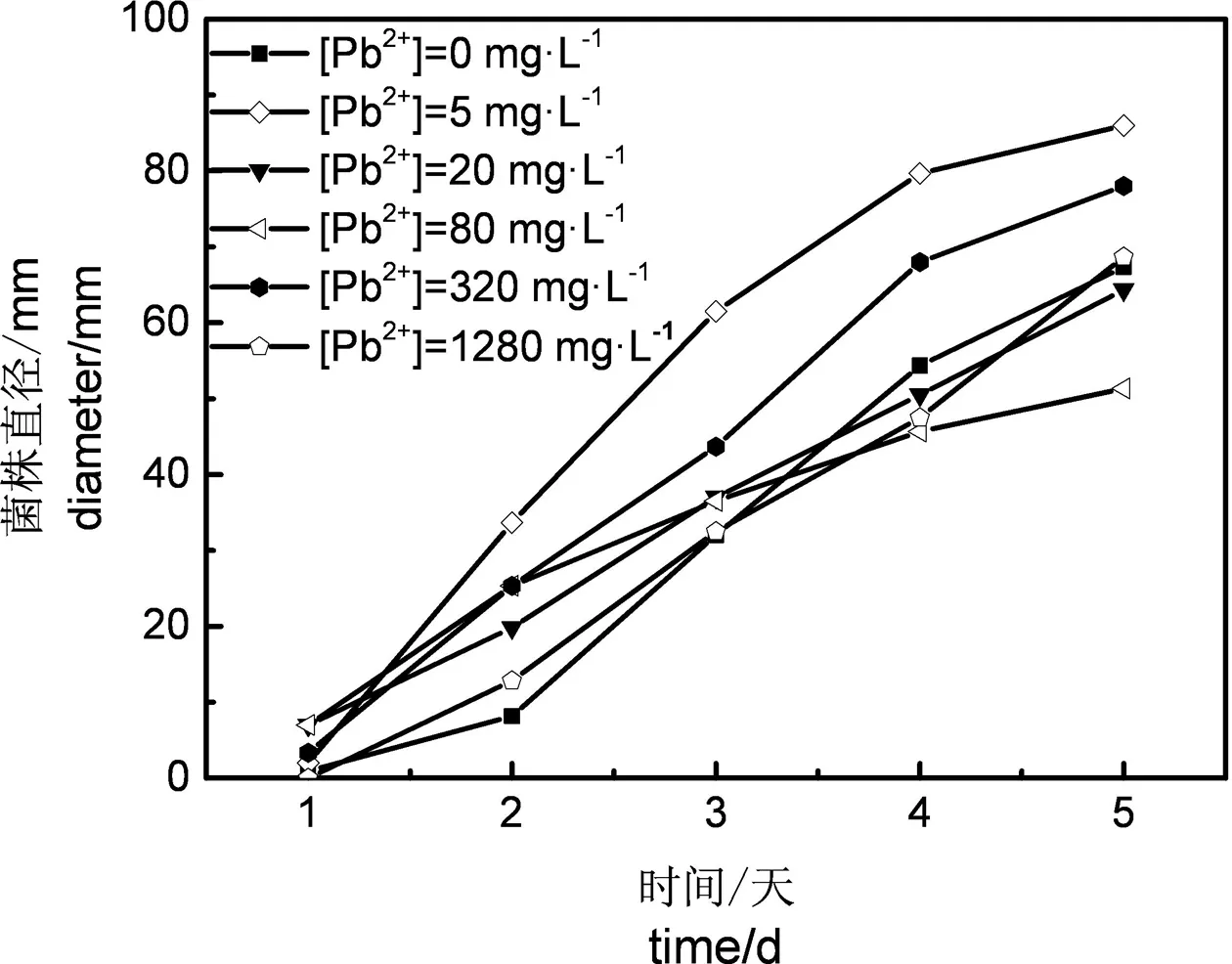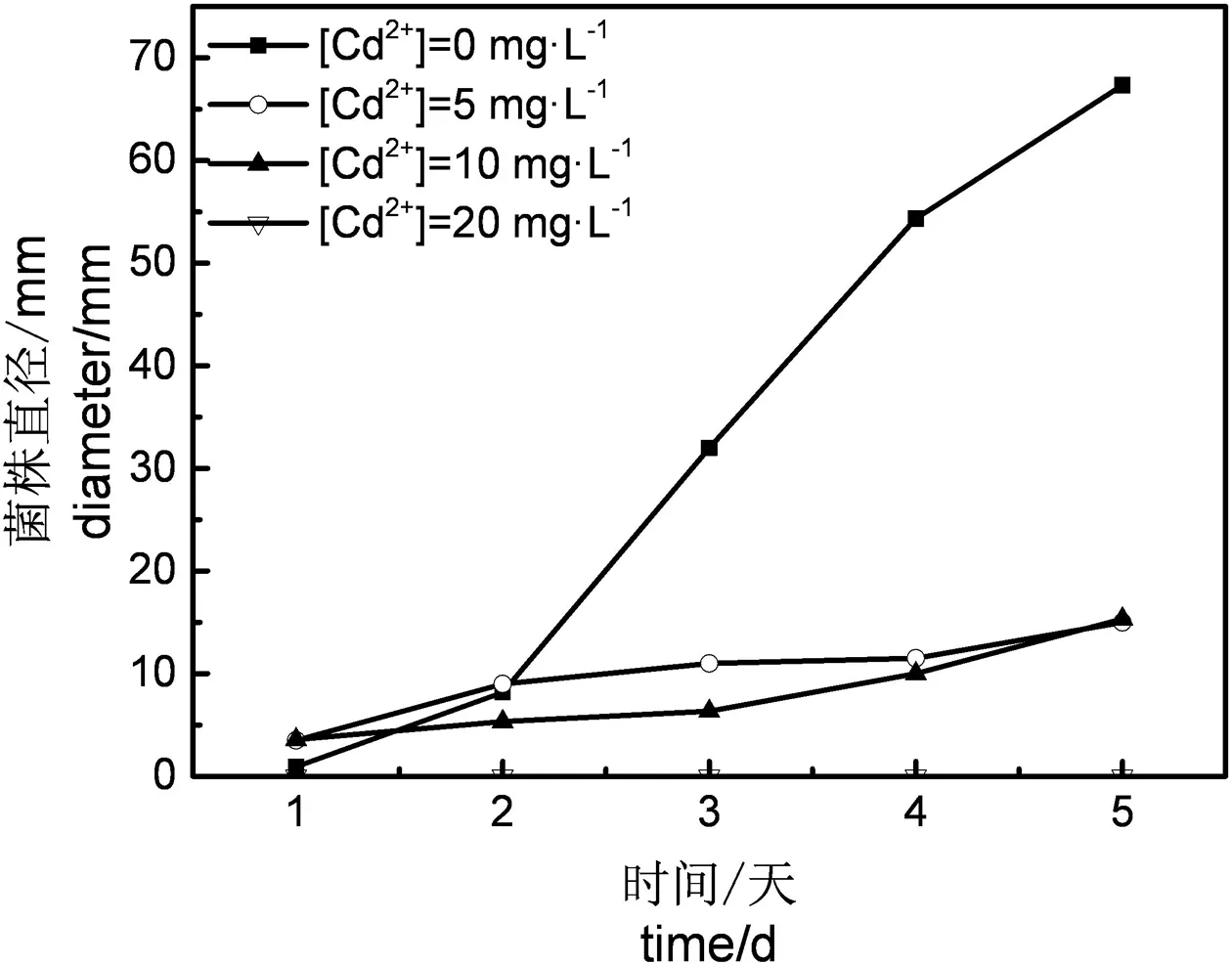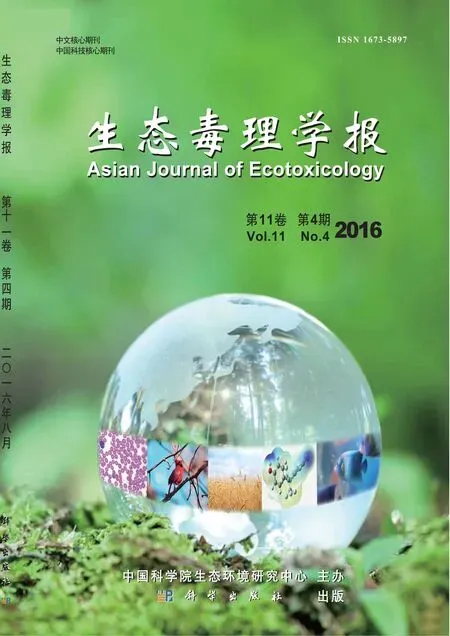重金屬對禾谷鐮刀菌的生長及毒素合成的影響
楊文杰,孫長坡,孫運海,姚瑞華,孫宏亮,馬樂寬,*
1. 環境保護部環境規劃院,北京 100012 2. 國家糧食局科學研究院,北京 100037
?
重金屬對禾谷鐮刀菌的生長及毒素合成的影響
楊文杰1,孫長坡2,孫運海1,姚瑞華1,孫宏亮1,馬樂寬1,*
1. 環境保護部環境規劃院,北京 100012 2. 國家糧食局科學研究院,北京 100037
以禾谷鐮刀菌為研究對象,研究了常見重金屬(Cu、Pb、Zn、Cd)對禾谷鐮刀菌菌株生長及其毒素合成的影響。研究結果表明,重金屬對菌株的生長和其產毒能力均產生影響。Cu2+和Cd2+對菌株生長影響較大,隨著濃度的增加對生長的抑制作用增強,當離子濃度分別為20 mg·L-1和40 mg·L-1時,能夠完全抑制菌株生長。Zn2+在0~160 mg·L-1濃度范圍內促進菌株生長,在10 mg·L-1濃度下促進毒素合成。Pb2+在察氏培養基中對菌株生長的影響沒有明顯規律可循,但是,隨著Pb2+濃度增加,抑制毒素合成作用增強。
重金屬;產毒素真菌;菌落直徑;玉米赤霉烯酮
目前,農田土壤重金屬污染日益突出。由于其在介質中移動性差,滯留時間長,不能被微生物降解,具有隱蔽性、長期性和不可逆的特點[1],且可以通過食物鏈進入人體,潛在危害大[2],所以農田土壤的重金屬污染已逐漸引起大家的重視。但是,現有研究鮮有關于重金屬對農產品中真菌毒素產生的影響。選取禾谷鐮刀菌作為供試菌株,研究重金屬對其生長和毒素產生的影響。玉米赤霉烯酮(zearalenone,ZEN)是禾谷鐮刀菌的代謝產物[3]。糧食作物在生長過程后期或糧食在運輸和儲存過程中,由于溫度、濕度等環境因素變化,可能導致玉米、水稻、麥類等谷物的禾谷鐮刀菌浸染并導致ZEN污染,其可以通過食物鏈富集,最終威脅人體健康[4]。2011年10月20日開始實施的食品安全國家標準GB 2761—2011《食品中真菌毒素限量》中規定:玉米赤酶烯酮在谷物中的限量為60 mg·kg-1。由于其在自然界污染的普遍性和廣泛的毒性作用,被給予了充分關注。ZEN生物毒性強,控制其在谷物中的含量對保證人體健康以及畜牧養殖等尤為重要[5]。
雖然糧食中的重金屬污染和真菌及其毒素污染一直是國內外學者研究的熱點,但至今為止,國內外研究主要集中于糧食中重金屬和毒素的單一污染,鮮有關于重金屬對糧食中真菌及其毒素合成影響的研究。因此,本文嘗試探討重金屬對禾谷鐮刀菌及其產毒素的影響,以探討糧食中的重金屬污染對產毒素真菌的生長和其產生毒素能力的影響,為谷類糧食作物的多污染防控提供理論支持。
1 材料與方法(Materials and methods)
1.1 實驗材料
供試菌株:禾谷鐮刀菌株(Fusarium graminearum),國家糧食局糧食科學研究院提供;供試重金屬:Cd(NO3)2,Cu(NO3)2,Zn(NO3)2,Pb(NO3)2,上述試劑均為分析純,購自北京化學試劑廠;玉米粉為普通玉米粉,購于中國農業科學院。
察氏培養基:根據文獻所述配制真菌培養基[6],蔗糖,NaNO3,K2HPO4,KCl,MgSO4·7H2O,FeSO4,蒸餾水,加入1.0 mL濃度為0.1%的FeSO4溶液,混勻后分裝滅菌。如需要固體培養基,則在滅菌前加入0.2%的瓊脂粉。
玉米培養基:150 mL錐形瓶中加20 g玉米粉,密封后于121 ℃滅菌20 min,冷卻至室溫后加入30 mL無菌水,充分混合。按需加入待測金屬溶液。
1.2 實驗方法
1.2.1 重金屬對菌株生長影響
實驗設置不同濃度重金屬對禾谷鐮刀菌進行處理。在無菌操作條件下,采用接種環點種法接種菌株。接種完成的培養基置于31 ℃恒溫培養箱中培養。在菌株生長1、2、3、4、5 d時,采用十字交叉法[7]測量菌落直徑,每組實驗設置3個平行,計算各處理組的單株平均值,作為各組菌落的直徑。
1.2.2 重金屬對毒素合成的影響
實驗設置不同濃度重金屬對禾谷鐮刀菌進行處理。配制含不同重金屬濃度的玉米培養基,接種菌液,每組實驗設置3個平行。暗光下于25 ℃在生化培養箱中培養1周,再將溫度調至20 ℃培養3周,提取并使用高效液相色譜法[8]測定培養液毒素量。
2 結果與討論 (Results and discussion)
2.1 菌株的生長情況
根據微生物不同生長時期的菌落直徑變化趨勢,繪制了禾谷鐮刀菌生長曲線。菌株生長曲線結果如圖1~圖4所示。

圖1 Zn2+處理下的禾谷鐮刀菌菌株生長曲線(菌落直徑)Fig. 1 Effects of Zn2+ on the strain growth of Fusarium graminearum (colony diameter)
從不同濃度Zn2+處理下菌株的生長曲線(圖1)可以看出,不同Zn2+濃度處理下,菌落的直徑隨著時間的變化均呈現上升趨勢。生長5 d后的菌落直徑隨著Zn2+濃度的增加其增長趨勢逐漸趨緩,表現出一定的激活-抑制效應。結果表明,Zn2+濃度在0 ~160 mg·L-1時,對禾谷鐮刀菌的生長起促進作用。隨著Zn2+濃度的增加,當Zn2+濃度大于640 mg·L-1時,禾谷鐮刀菌生長5 d后的菌落直徑小于空白組,開始表現為抑制作用,并且隨著Zn2+濃度的增加抑制作用增強。其原因可能是: Zn2+是微生物必需的營養微量元素之一[9],對真菌的生長起促進作用,能夠增加菌株干物質的積累。孟麗等[10]在研究Zn2+處理對真菌生長發育的影響中也發現了類似的規律。本研究結果還表明,高濃度Zn2+處理對禾谷鐮刀菌生長起抑制作用,其原因可能是高濃度的Zn2+對菌株具有一定的毒性。聶湘平等[11]在研究中也發現高濃度的Zn2+處理對真菌有抑制效應。


圖2 Pb2+處理下的禾谷鐮刀菌菌株生長曲線(菌落直徑)Fig. 2 Effects of Pb2+ on the strain growth of Fusarium graminearum (colony diameter)

圖3 Cd2+處理下的禾谷鐮刀菌菌株生長曲線(菌落直徑)Fig. 3 Effects of Cd2+ on the strain growth of Fusarium graminearum (colony diameter)
圖3為不同濃度Cd2+處理下菌株的生長曲線,可以看出,隨著Cd2+處理濃度的增加,生長5 d后的菌落直徑明顯下降,說明Cd2+抑制了菌體的正常生長,呈現劑量-效應關系[14]。當Cd2+濃度達到20 mg·L-1時,能夠完全抑制菌株生長,與李勇等[12]研究結果一致。其原因可能是重金屬離子與酶或其他大分子物質結合,導致生物個體病變和死亡。謝燕等[15]的研究也發現了類似現象。

圖4 Cd2+處理下的禾谷鐮刀菌菌株生長曲線(菌落直徑)Fig. 4 Effects of Cu2+ on the strain growth of Fusarium graminearum (colony diameter)
從不同濃度Cu2+處理下菌株的生長曲線可以看出,隨著Cu2+濃度的增加,生長5 d后的菌落直徑逐漸減小,Cu2+對菌株的生長抑制作用增強,當Cu2+濃度達到40 mg·L-1時,能夠完全抑制禾谷鐮刀菌的生長。本研究與楊瑞恒等[16]和Muccifora等[17]的研究結果一致。其原因可能是由于Cu2+是一種殺菌劑[18],具有很強的殺菌能力。洪法水等[19]的研究表明,由于真菌對金屬的選擇性吸收,使得某些特定的金屬離子具有很強的殺菌能力。
2.2 重金屬對ZEN合成的影響
本研究中實驗所用玉米粉中原有的重金屬含量忽略不計。重金屬對毒素合成的影響結果如表1所示。

表1 不同濃度重金屬下玉米赤霉烯酮(ZEN)毒素的合成
從表1中可以看出,Pb2+、Cu2+和Cd2+處理組中菌株的毒素合成均小于空白對照組,表現為抑制作用,并且隨著金屬離子濃度的增加,ZEN含量呈現下降趨勢,對菌株毒素合成的抑制作用增強,和Pb2+、Cu2+和Cd2+對菌株生長的影響規律一致。加入Zn2+的玉米培養基中,隨著Zn2+濃度的增加,ZEN的含量呈現先上升后下降的趨勢,與孫建和等[20]的研究結果一致。當Zn2+濃度為10 mg·L-1時,ZEN的含量大于空白組,表現為促進菌株毒素的合成,其原因可能是由于鋅是微生物體營養類微量元素,在適宜濃度的Zn2+處理下能顯著提高孢子存活率,郝俊冉[21]的研究結果也得到了相同的結論。低濃度Zn2+(10 mg·L-1)對真菌毒素的合成起到促進作用,所以控制鋅污染力度應加強,因為出現鋅污染的區域很可能同時存在較重的真菌和真菌毒素污染。綜合以上研究結果可以看出,在Cu2+、Zn2+和Cd2+作用下,菌株產生的毒素含量和菌株的生長呈正相關,和郭新梅等[22]研究結果一致。原因之一可能是由于重金屬促進或抑制了酶活性,從而影響了菌株的生長和代謝。雖然隨培養體系重金屬含量增加,真菌毒素下降,但是并不能直接說明谷物重金屬污染可以降低ZEN的污染風險。環境重金屬污染對谷物的影響以及對產毒真菌的影響之間相關性問題還需深入研究。
[1] Lei M, Tie B Q, Song Z G, et al. Heavy metal pollution and potential health risk assessment of white rice around mine areas in Hunan Province, China [J]. Food Security, 2015, 7(1): 45-54
[2] Islam E U, Yang X E, He Z L, et al. Assessing potential dietary toxicity of heavy metals in selected vegetables and food crops [J]. Journal of Zhejiang University: Science B, 2007, 8(1): 1-13
[3] Ramos A J, Marín S, Sanchis V, et al. Fusarium verticillioides and Fusarium graminearum infection and fumonisin B1 and zearalenone accumulation in resveratrol-treated corn [J]. Food Science and Technology International, 2006, 12(4): 353-359
[4] Czeh A. A flow cytometry based competitive fluorescent microsphere immunoassay (CFIA) system for detecting up to six mycotoxins [J]. Journal of Immunological Methods, 2012, 384: 71-80
[5] Zinedine A, Soriano J M, Moltó J C, et al. Review on the toxicity, occurrence, metabolism, detoxification, regulations and intake of zearalenone: An oestrogenic mycotoxin [J]. Food and Chemical Toxicology, 2007, 45(1): 1-18
[6] 錢存柔. 微生物學實驗教程[M]. 北京:北京大學出版社, 1999: 56-58
Qian C R. Laboratory Experiments in Microbiology [M]. Beijing: Peking University Press, 1999: 56-58 (in Chinese)
[7] 楊煥青, 王開運, 范昆, 等. 草莓枯萎病菌的生物學特性及7種殺菌劑對其抑制作用[J]. 植物保護學報, 2008, 35(2): 169-174
Yang H Q, Wang K Y, Fan K, et al. Biological characteristics of strawberry Fusarium wilt and inhibitory effects of seven fungicides [J]. Acta Phytophylacica Sinica, 2008, 35(2): 169-174 (in Chinese)
[8] 王裕中. 中國小麥赤霉病菌優勢種——禾谷鐮刀菌產毒素能力的研究[J]. 真菌學報, 1994(3): 229-234
Wang Y Z. Toxin producing potential of Fusarium graminearum from China [J]. Acta Mycologica Sinica, 1994(3): 229-234 (in Chinese)
[9] Stefanidou M. Zinc: A multipurpose trace element [J]. Archives of Toxicology, 2006, 80(1): 1-9
[10] 孟麗, 簡在友, 李孝偉, 等. 金銀花藤培養基中加鋅對香菇菌絲生長的影響[J]. 湖北農業科學, 2007, 46(2): 251-252
Meng L, Jian Z Y, Li X W, et al. Effect of honeysuckle rattan-Zn2+medium on the growth of Lentinusedodes hypha [J]. Hubei Agricultural Sciences, 2007, 46(2): 251-252(in Chinese)
[11] 聶湘平, 藍崇鈺, 束文圣, 等. 鋅對大葉相思-根瘤菌共生固氮體系影響研究[J]. 植物生態學報, 2002, 26(3): 264-268
Nie X P, Lan C Y, Shu W S, et al. Effects of zinc on Rhizobia-earleaf acacia (Acacia auriculaeformis) symbiotic association [J]. Acta Phytophylacica Sinica, 2002, 26(3): 264-268 (in Chinese)
[12] 李勇, 黃占斌, 王文萍, 等. 重金屬鉛鎘對玉米生長及土壤微生物的影響[J]. 農業環境科學學報, 2009, 28(11): 2241-2245
Li Y, Huang Z B, Wang W P, et al. Effects of heavy metals lead and cadmium on Zea mays L. growth and the soil microorganism [J]. Journal of Agro-environment Science, 2009, 28(11): 2241-2245 (in Chinese)
[13] 王亮. 白腐真菌胞外聚合物的產量、組分及其對菌體吸附鉛的機理研究[D]. 長沙: 湖南大學, 2011
Wang L. Yield and composition of extracellular polymeric substances (EPS) by white-rot fungi and mechanism of its biosorption of Pb2+[D]. Changsha: University of South China, 2011 (in Chinese)
[14] 劉慧, 張宇宏, 張少斌, 等. Cd2+脅迫對螺旋藻生長、光譜特性及藻膽蛋白質量濃度的影響[J]. 生態環境, 2007, 16(3): 767-770
Liu H, Zhang Y H, Zhang S B, et al. Effects of Cd2+on the growth, spectroscopic properties and phycobiliprotein content of Spirulina platensis [J]. Ecology and Environment, 2007, 16(3): 767-770 (in Chinese)
[15] Yan X, Luo H, Du Z, et al. Identification of cadmium-resistant fungi related to Cd transportation in bermudagrass. Cynodon dactylon (L.) Pers [J]. Chemosphere, 2014, 117: 786-792
[16] 楊瑞恒, 姚青, 郭俊, 等. 磷和鎘對根內球囊霉Glomus intraradices孢子萌發、菌絲生長和外生菌絲內聚磷酸累積的影響[J]. 菌物學報, 2010, 29(3): 421-428
Yang R H, Yao Q, Guo J, et al. Influence of P and Cd on the spore germination, hyphal growth and polyphosphate accumulation in extraradical hyphae of Glomus intraradices [J]. Mycosystema, 2010, 29(3): 421-428 (in Chinese)
[17] Muccifora S. Effects of copper on spore germination, growth and ultrastructure of Polypodium cambricum L. gametophytes [J]. Environmental Pollution, 2008, 153(2): 369-375
[18] Viti C,Quaranta D, Philippis R D, et al. Characterizing cultivable soil microbial communities from copper fungicide-amended olive orchard and vineyard soils [J]. World Journal of Microbiology & Biotechnology, 2007, 24(3): 309-318
[19] 洪法水, 王雪峰, 吳康, 等. 重金屬離子對豬胰α-淀粉酶活性影響的作用機理研究[J]. 高等學校化學學報, 2001, 22(12): 1979-1983
Hong F S, Wang X F,Wu K, et al. Mechanism of heavy metal ions on α-amylase activity from porcine pancreas [J]. Chemical Journal of Chinese Universities, 2001, 22(12): 1979-1983 (in Chinese)
[20] 孫建和, 陸蘋, 顧紅香, 等. 真菌毒素的微生物脫毒技術[J]. 微生物學通報, 2003, 30(1): 60-63
Sun J H, Lu P, Gu H X, et al. Microbial detoxification of mycotoxins technology [J]. Microbiology, 2003, 30(1): 60-63 (in Chinese)
[21] 郝俊冉. 谷胱甘肽和鋅離子緩解赭曲霉毒素A毒性的組學研究[D]. 北京:中國農業大學, 2015
Hao J R. Omics analysis on mechanisms of glutathione and zinc ion in relieving ochratoxin A-induced toxicity [D]. Beijing: China Agricultural University, 2015 (in Chinese)
[22] 郭新梅, 陳耀鋒, 李春蓮, 等. 禾谷鐮刀菌粗毒素對不同小麥品種幼苗MDA含量和SOD、PAL活性的影響 [J]. 西北植物學報,2007, 27(1): 68-73
Guo X M, Chen Y F, Li C L, et al. Effects of Fusarium graminearum crude toxin on MDA contents and SOD and PAL activities in the seedlings of different wheat varieties [J]. Acta Botanica Boreali-Occidentalia Sinica, 2007, 27(1): 68-73 (in Chinese)
Influence of Heavy Metals on the Growth and Toxin Synthesis of Fusarium graminearum
Yang Wenjie1,Sun Changpo2,Sun Yunhai1,Yao Ruihua1,Sun Hongliang1,Ma Lekuan1,*
1. Chinese Academy for Environmental Planning, Beijing 100012, China 2. Academy of State Administration of Grain, Beijing 100037, China
Received 3 March 2016 accepted 9 May 2016
Effects of heavy metals including Cu, Cd, Zn and Pb on the strain growth and toxin synthesis of Fusarium graminearum were investigated. The results indicated that the concentration and type of heavy metals had impact on the growth and toxin synthesis of the strain. The growth of the strain was inhibited increasingly with the increase of Cu2+and Cd2+concentrations in the culture media, and no growth was observed when the concentrations reached 20 mg·L-1and 40 mg·L-1, respectively. The growth of the strain was promoted under the Zn2+treatment with the concentration ranging from 0 mg·L-1to 160 mg·L-1, but the toxin synthesis was promoted within 10 mg·L-1. The effect of Pb2+on the growth of the strain was not well-regulated, but the inhibition of toxin synthesis was enhanced with the increase of Pb2+concentration.
heavy metals; mycotoxins; colony diameter; zearalenone
楊文杰(1980-),女,助理研究員,研究方向為水污染防治,E-mail: wjyang1109@126.com;
*通訊作者(Corresponding author), E-mail: malk@caep.org.cn
10.7524/AJE.1673-5897.20160303002
2016-03-03 錄用日期:2016-05-09
1673-5897(2016)4-211-05
X171.5
A
簡介:馬樂寬(1978—),男,博士,副研究員,主要研究方向為水污染防治。
楊文杰,孫長坡,孫運海, 等. 重金屬對禾谷鐮刀菌的生長及毒素合成的影響[J]. 生態毒理學報,2016, 11(4): 211-215
Yang W J, Sun C P, Sun Y H, et al. Influence of heavy metals on the growth and toxin synthesis of Fusarium graminearum [J]. Asian Journal of Ecotoxicology, 2016, 11(4): 211-215 (in Chinese)

